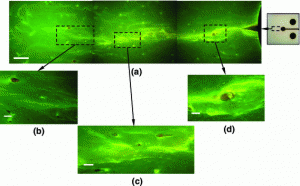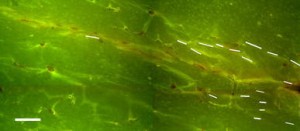Now obviously, if walking was able to increase height people would be a lot taller? But if repetitive stress can induce plastic changes in cortical bone that could possibly contribute to height gain. More on plastic deformation here. Michael talks about the definition of Plastic deformation here and he talks about the values needed to induce plastic deformation here.
One possibility as to why inducing microcracks to cause plastic(permanent) changes in bone length is that most microcracks such as those induced by walking would be more compressive microcracks rather than tensile strain microcracks which would be what would be needed to make a bone longer. One study finding longitudinal decrease in height in the lower legs would be consistent with the fact that typical athletic stimuli induces compressive changes rather than lengthening changes. Although another study also mentioned in the same post found that exercise increased height slightly in the spine. Although it would be logical to think that kicking with ankle weights would be one such stimuli to induce longitudinal plastic deformation of the bone.
Effects of fatigue induced damage on the longitudinal fracture resistance of cortical bone.
“As a composite material, cortical bone accumulates fatigue microdamage through the repetitive loading of everyday activity (e.g. walking). Twenty longitudinally orientated compact tension fracture specimens were machined from a single bovine femur, ten specimens were assigned to both the control and fatigue damaged groups. The damaged group underwent a fatigue loading protocol to induce microdamage which was assessed via fluorescent microscopy. Following fatigue loading, non-linear fracture resistance tests were undertaken on both the control and damaged groups using the J-integral method. The interaction of the crack path with the fatigue induced damage and inherent toughening mechanisms were then observed using fluorescent microscopy. Fatigue induced damage reduces the initiation toughness of cortical bone and the growth toughness within the damage zone by three distinct mechanisms of fatigue-fracture interaction. Further analysis of the J-integral fracture resistance showed both the elastic and plastic component were reduced in the damaged group. For the elastic component this was attributed to a decreased number of ligament bridges in the crack wake while for the plastic component this was attributed to the presence of pre-existing fatigue microcracks preventing energy absorption by the formation of new microcracks.”
“The composite structure of bone consists of three main components, this includes: collagen type I (organic phase), calcium hydroxyapatite (inorganic or mineral phase) and water [8]. These components are arranged hierarchically from macro to nano scale giving bone distinct material behaviour at each characteristic scale. This composite structure causes bone to form microdamage due to fatigue loading. In bone there are two main types of fatigue damage observed (linear microcracks and diffuse damage), which can be linked to different modes of loading. Another consequence of the composite structure of bone is that it exhibits rising fracture toughness with crack extension (i.e. a rising fracture resistance curve). As a macrocrack propagates through bone, microcracks form in the process zone at the tip of the main propagating crack. This damage can act to reduce the driving force available for crack growth by dissipating energy away from the main crack extension and also provides initiation sites for toughening mechanisms, such as uncracked ligament bridges and crack deflection. Pre-existing fatigue microdamage in the crack path can potentially interact with these mechanisms and alter the fracture resistance.”
In the study a microcrack was induced with a drill so it’s hard to extrapolate the results here to what would happen in various of forms of mechanical stimuli.
This image shows microcracks in bone. You can see the drill induced crack on the part of a directly above c.
“a crack path of a typical control specimen showing various toughening mechanisms along the crack path: b microcracking ahead of the tip of the main crack, c several ligament bridges and d deflection and ligament bridge formation.”<-I think this kind of cracking could induce longitudinal bone growth however it would require an initial macrocrack such as that induced by the drill. If you look at the a image directly above d the ligament bridging covers the entire length of the bone which could potentially result in total longitudinal bone growth.
“Typical damaged specimen following resistance curve testing. The approximate location of the pre-existing fatigue microcracks are marked using white lines. Scale bar is 250 µm”
Exercises like kicking with ankle weights can cause microcracks which can increase the likelihood of getting those macrocracks which can result in plastic deformation like longitudinal bone length increase. But macrocracks are likely needed to induce that plastic strain in bone and only extreme ankle weight kicking is likely to induce that.
The bone constantly changes in length throughout the day by definition of microstrain. Just cause a “macrocrack in bone” whole the bone is slightly lengthened and repeat and you should gradually grow taller.


